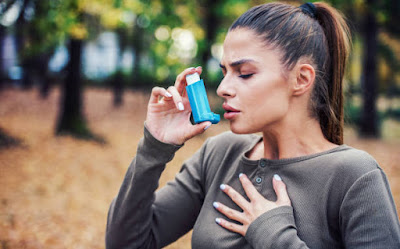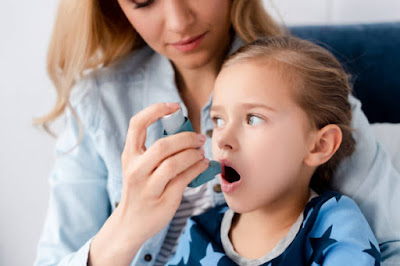Read more
What is Asthma?
The air pipes (bronchi) in the lungs of individuals with asthma are touchy. At the point when these individuals are presented to specific trigger factors, their aviation routes contract, making it hard for them to relax.
Two main factors cause the airways to narrow:
1. The internal surface of the flight courses becomes red and amplified (disturbance), and extra bodily fluid (natural liquid - a crude liquid) may be released. 2. The muscles around the aviation routes contract (limiting of the bronchial lumen).
Why do people develop asthma?
The causes of asthma are not fully known. Notwithstanding, innate inclination is for the most part seen in sicknesses like asthma, skin inflammation, or roughage fever. Offspring of moms who smoked during pregnancy and kids presented to tobacco smoke in youth are at higher danger of creating asthma.
What are the main symptoms of asthma?
Wheezing - making a raspy or whistling sound while breathing Chest tightness Shortness of breath Cough Asthma symptoms differ from person to person. Some people may have all of these symptoms, while others may only have wheezing or coughing.
What are the factors that trigger asthma symptoms?
Factors that trigger asthma symptoms can also vary from person to person. The most common trigger factors are:
Cold and flu (especially in children) Exercise (this is controllable) Pollen, mold, and grass Animal hair and skin remains Micro-organisms in house dust Cigarette smoke Changes in temperature and weather Certain medications (for example, aspirin and some blood pressure medication) Additives, flavorings, and coloring substances in some foods and foods some professions certain emotional states (e.g. stress) It can be difficult to identify the factors that trigger asthma in some people! Advice your essential consideration doctor for clear information with respect to this. Can asthma be treated? In such manner, many individuals with asthma can continue with their day by day exercises without showing asthma side effects. Great control of asthma permits you to lead a functioning and solid life.
Good control of asthma requires:
1. Using asthma medications as directed 2. Monitoring asthma 3. Maintaining an active and healthy life 4. Avoiding triggers whenever possible 5. Obtaining a written asthma action plan 6. Going to the doctor regularly Each of these will be explained in more detail in the next section.
Using Asthma Medications The best way to control asthma is to use medications as directed.
There are three main types of asthma medications:
i) Preventive Medicines Inhaled medicines (asthma sprays/inhalers): Becloforte*, Becotide*, Flixotide, Intal, Intal Forte, Pulmicort, Qvar and Tilade Tablets: Singulair Relief tablets or syrups: Prednisone, Prednisolone, Redipred, Premix These drugs reduce the sensitivity of the airways and help people with asthma to be healthy. These medications decrease the affectability of the aviation routes and help individuals with asthma to be solid.
rugs reduce the sensitivity of the airways and help people with asthma to be healthy. Preventive drugs diminish redness and expanding on the internal surfaces of the aviation routes and evaporate the bodily fluid. These drugs make the person feel better within a few weeks. Medication boxes are ordinarily brown, orange, yellow, or white.
Preventive drugs for the most part should be required each day, regardless of whether the individual feels great.
Try not to quit taking preventive meds except if suggested by your PCP.
In case you can't handle your asthma, your PCP might recommend a short course (2-14 days) of Prednisone/Prednisolone tablets or Redipred/Premix syrup that will get you well soon. They are also known as "rescue drugs".
Combined drugs: Seretide
These meds are a mix of an additive and a side effect control prescription taken together in an inhaler.It is a blend of Seretide (purple shaded box), Flixotide (additive), and Serevent (indication regulator).
ii) Relievers Inhaled medicines (asthma sprays/inhalers): Airomir, Asmol, Bricanyl, Ipaq, and Ventolin These medicines reduce asthma symptoms (wheezing, chest tightness, shortness of breath, and cough) within a few minutes. Loosening up drugs loosen up the muscles around the aviation routes with the goal that the aviation routes extend and the individual inhales all the more without any problem. The boxes of drugs are usually blue. You should always carry your blue reliever inhaler with you. Blue-hued inhalers are vital in the medical aid therapy of asthma.
The need to utilize the blue reliever more than 3-4 times each week to calm asthma manifestations (other than pre-practice side effects) might be an indication that your asthma is
not well controlled. You should discuss this with your doctor. Atrovent is an alternate kind of relaxant that is at times utilized with one of the blue relaxants referenced previously.
iii) Symptom Controller Medications Inhaled medications (asthma sprays/inhalers): Foradile, Oxis, and Serevent
Manifestation controlling prescriptions
(likewise called long-acting relievers) help the muscles around the aviation routes stay loose for as long as 12 hours. These medications are not ordinarily utilized in the emergency treatment of asthma. A symptom controller can be given to people whose asthma symptoms do not go away despite using corticosteroid prophylactic drugs (Becloforte, Becotide, Flixotide, Pulmicort, or Qvar) that are inhaled with normal breathing. In the event that your youngster has asthma, converse with your primary care physician regarding which prescription may be best for him. Asthma is a sickness that advances contrastingly in each youngster. In this way, your PCP will recommend the most appropriate medication for your youngster.
Asthma monitoring
Asthma symptoms diary This is the preferred method of monitoring asthma in children under 7 years of age. Asthma in children is mostly seasonal, and many children only need treatment during the winter season. Youngsters with asthma should be checked for their development and advancement, as development and improvement might be pretty much influenced by the two medicines.
All youngsters with typical asthma side effects ought to have a composed asthma plan.
Recording maximum breath readings show whether your airways are wide or narrow. An increment in asthma manifestations or a diminishing in greatest broadness readings demonstrates that your asthma is declining.





0 Reviews